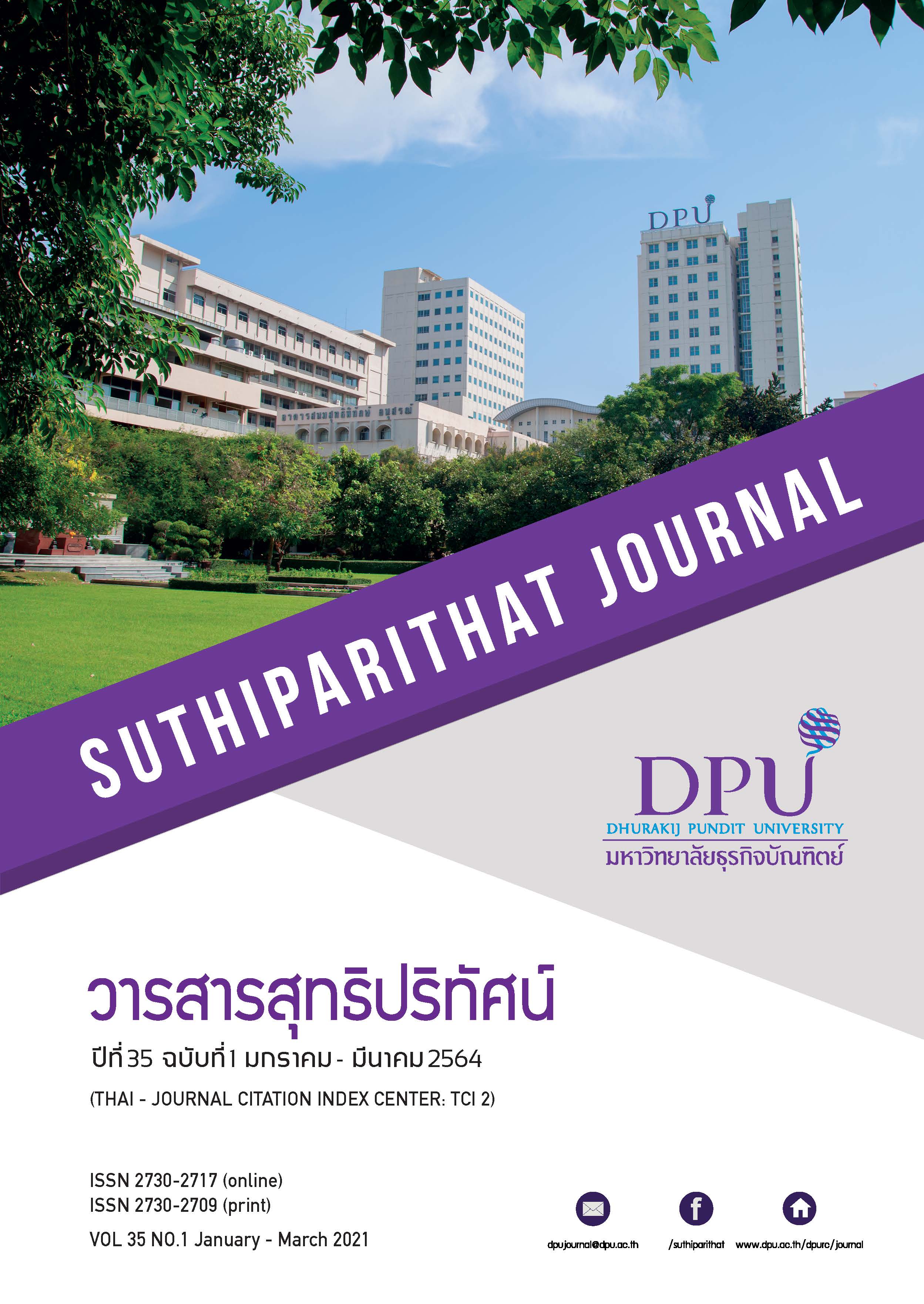การวิเคราะห์องค์ประกอบเชิงยืนยันของความผูกพันต่อองค์กรของพนักงานบริการส่วนหน้าในธุรกิจเชนกาแฟมวลชน
คำสำคัญ:
ความผูกพันต่อองค์กร, พนักงานบริการส่วนหน้า, การวิเคราะห์องค์ประกอบเชิงยืนยันบทคัดย่อ
งานวิจัยนี้มีวัตถุประสงค์เพื่อวิเคราะห์องค์ประกอบเชิงยืนยันความผูกพันต่อองค์กรของพนักงานบริการส่วนหน้าในธุรกิจเชนกาแฟมวลชน โดยเก็บข้อมูลกลุ่มตัวอย่างจากพนักงานบริการส่วนหน้าเชนกาแฟมวลชนจำนวน 300 คน ด้วยวิธีการสุ่มตัวอย่างแบบง่าย เครื่องมือที่ใช้เก็บรวบรวมข้อมูล ได้แก่ แบบสอบถามออนไลน์ และใช้โปรแกรมทางสถิติในการวิเคราะห์ข้อมูล
ผลการวิจัยพบว่า การวิเคราะห์โมเดลองค์ประกอบเชิงยืนยันอันดับที่สองความผูกพันต่อองค์กรทั้ง 3 องค์ประกอบมีความสอดคล้องกลมกลืนกับข้อมูลเชิงประจักษ์ โดยมีค่าไคสแควร์เท่ากับ 172.039 ค่าองศาอิสระเท่ากับ 167 ค่าไคสแควร์สัมพัทธ์เท่ากับ 1.032 ค่า p-value เท่ากับ .373 ค่าดัชนีวัดระดับความกลมกลืนเท่ากับ .954 ค่าดัชนีวัดระดับความสอดคล้องกลมกลืนเปรียบเทียบเท่ากับ .999 ค่าดัชนีรากกำลังสองเฉลี่ยของเศษเหลือเท่ากับ .020 และค่ารากของค่าเฉลี่ยกำลังสองของความคลาดเคลื่อนโดยประมาณเท่ากับ .010 โดยความผูกพันต่อองค์กร ทั้ง 3 องค์ประกอบมีค่าสัมประสิทธิ์สหสัมพันธ์พหุคูณในเกณฑ์ที่ดีเรียงลำดับจากมากไปน้อย คือ องค์ประกอบด้านความผูกพันตามหน้าที่ มีค่าเท่ากับ .896 ด้านความผูกพันแบบต่อเนื่อง มีค่าเท่ากับ .861 และด้านความผูกพันตามความรู้สึก มีค่าเท่ากับ .846 ตามลำดับ ทั้งนี้ผู้ประกอบการธุรกิจเชนกาแฟควรให้ความสำคัญกับความผูกพันต่อองค์กรของพนักงานบริการส่วนหน้าที่มุ่งเน้นความผูกพันตามหน้าที่เพื่อนำพาองค์กรให้ประสบความสำเร็จและการแข่งขันของสภาพเศรษฐกิจในปัจจุบัน
เอกสารอ้างอิง
กสิกรไทย. (2563). ธุรกิจร้านกาแฟ บริหารอย่างไรให้รุ่ง. สืบค้น 23 เมษายน 2563, จาก https://kasikornbank.com/th/business/sme/KSMEKnowledge/article/KSMEAnalysis/Pages/Coffee-Shop-Management.aspx
ซีพี รีเทลลิงค์. (2563). รู้จัก ซีพี รีเทลลิงค์. สืบค้น 2 พฤษภาคม 2563, จาก https://www.cpretailink.co.th/mainpage/content.php?sec_id=0&cat_id=0
Allen, N. J., & Meyer, J. P. (1990). The measurement and antecedents of affective, continuance and normative commitment to the organization. Journal of Occupational Psychology, 63(1), 1-18.
Babakus, E., & Yavas, U. (2012). Customer orientation as a buffer against job burnout. The Service Industries Journal, 32(1), 5-16.
Battistelli, A., Galletta, M., Vandenberghe, C., & Odoardi, C. (2016). Perceived organisational support, organisational commitment, and self-competence among nurses: A study in two Italian hospitals. Journal of Nursing Management, 24(1), 44-53.
Brown, R. (1996). Organizational commitment: Clarifying the concept and simplifying the existing construct typology. Journal of Vocational Behavior, 49, 230-251.
Diamantopoulos, A., & Siguaw, J. A., (2000). Introduction to LISREL: A guide for the uninitiated. London: SAGE.
Dunham, R. B., Grube, J. A., & Castañeda, M. B. (1994). Organizational commitment: The utility of an integrative definition. Journal of Applied Psychology, 79(3), 370–380.
Gelaidan, M. H., & Ahmad, H. (2013). The factors affecting employee commitment to change in public sector: Evidence from Yemen. International Business Research, 6(3), 75-87.
Ghosh, S., & Swamy, D. R. (2014). A literature review on organizational commitment – A comprehensive summary. Int. Journal of Engineering Research and Applications, 4(12-1), 4-14.
He, P., Murmann, S. K., & Perdue, R. R. (2012). Management commitment and employee perceived service quality: The mediating role of affective commitment. The Journal of Applied Management and Entrepreneurship, 17(3), 79-97.
Lee, D. C., Hung, L. M., & Chen, M. L. (2012). Empirical study on the influence among corporate sponsorship, organisational commitment, organisational cohesiveness and turnover intention. Journal of Management and Sustainability, 2(2), 43-53.
Ma, E., Qu, H., & Wilson, M. (2016). The affective and dispositional consequences of organizational citizenship behavior: A cross-cultural study. Journal of Hospitality & Tourism Research, 40, 399-431.
Malbaši´c, I., Mas-Machuca, M., & Marimon, F. (2018). Through the decreased values gap to increased organizational effectiveness: The mediating role of organizational commitment. Journal of Human Values, 24(2), 101-115.
McCallum, S. Y., Forret, M. L., & Wolff, H. (2014). Internal and external networking behavior: An investigation of relationships with affective, continuance, and normative commitment. Career Development International, 19, 595-614.
Menguc, B., Auh, S., Fisher, M., & Haddad, A. (2013). To be engaged or not to be engaged: The antecedents and consequences of service employee engagement. Journal of Business Research, 66(11), 2163-2170.
Meyer, J. P., & Parfyonova, N. M. (2010). Normative commitment in the workplace: A theoretical analysis and re-conceptualization. Human Resource Management Review, 20(4), 283-294.
Mowday, R. T., Steers, R. M., & Porter, L. W. (1979). The measurement of organizational commitment. Journal of Vocational Behavior, 14, 224-247.
Schaufeli, W. B., & Bakker, A. B. (2010). Defining and measuring work engagement: Bringing clarity to the concept. In A. B. Bakker (Ed.) & M. P. Leiter, Work engagement: A handbook of essential theory and research. (pp. 10–24). Psychology Press.
Schepers, J. J., Nijssen, E. J. & van der Heijden, G. A. (2016). Innovation in the frontline: Exploring the relationship between role conflict, ideas for improvement, and employee service performance. International Journal of Research in Marketing, 33(4), 797-817.
Schumacker, R. E., & Lomax, R. G. (2010). A beginners guide to structural equation modeling. New York: Routledge.
Smith, K., Gregory, S. R., & Cannon, D. (1996). Becoming an employer of choice: Assessing commitment in the hospitality workplace. International Journal of Contemporary Hospitality Management, 8(6), 3-9.
Sun, L. Y., Aryee, S., & Law, K. S. (2007). High performance human resource practices, citizenship behaviour, and organisational performance: A relational perspective. Academy of Management Journal, 50(3), 558-577.
Walsh, K., & Taylor, M.S. (2007). Developing in-house careers and retaining management talent: What hospitality professionals want from their jobs? Cornell Hospitality Quarterly, 48(2), 163-182.
ดาวน์โหลด
เผยแพร่แล้ว
รูปแบบการอ้างอิง
ฉบับ
ประเภทบทความ
สัญญาอนุญาต
เนื้อหาและข้อมูลในบทความที่ลงตีพิมพ์ในวารสารสุทธิปริทัศน์ ถือเป็นข้อคิดเห็นและความรับผิดชอบของผู้เขียนบทความโดยตรงซึ่งกองบรรณาธิการวารสาร ไม่จำเป็นต้องเห็นด้วย หรือร่วมรับผิดชอบใด ๆ
บทความ ข้อมูล เนื้อหา รูปภาพ ฯลฯ ที่ได้รับการตีพิมพ์ในวารสารสุทธิปริทัศน์ ถือเป็นลิขสิทธิ์ของวารสารสุทธิปริทัศน์หากบุคคลหรือหน่วยงานใดต้องการนำทั้งหมดหรือส่วนหนึ่งส่วนใดไปเผยแพร่ต่อหรือเพื่อกระทำการใด ๆ จะต้องได้รับอนุญาตเป็นลายลักษณ์อักษรจากวารสารสุทธิปริทัศน์ก่อนเท่านั้น







